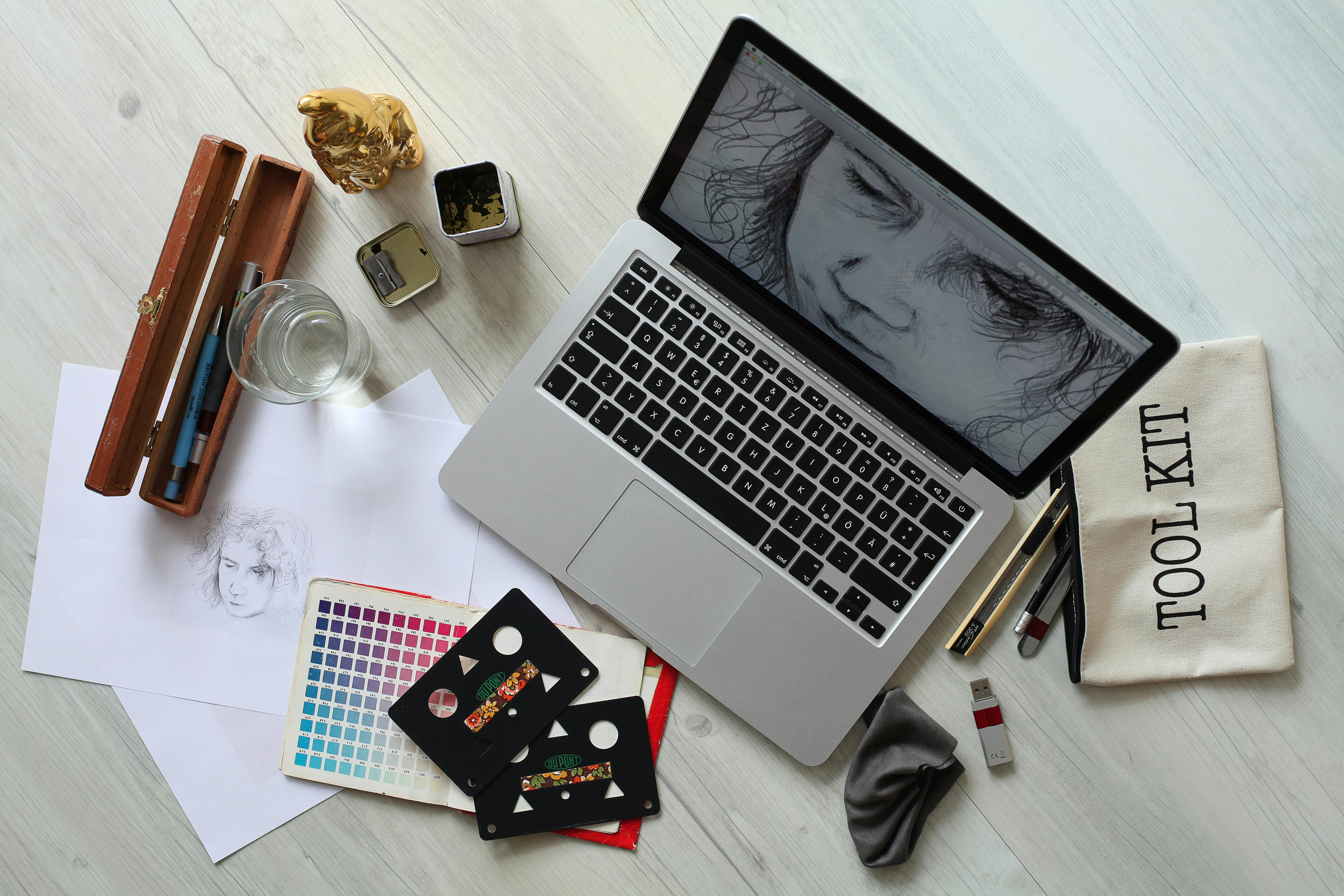11 Essential Digital Illustration Techniques
by WriteSeen
Curious about the latest digital illustration techniques transforming the creative world? This guide lays out 11 essential methods, from mastering the basics of digital art to crafting stunning vector graphics and immersing in textured brushwork.
Perfect for both upcoming talents and seasoned pros, our insights promise to enhance your creative edge, elevate your work, and make your art stand out. Ready to supercharge your skills? Let's explore the tools that will shape your artistic future.
1. Mastering the Basics of Digital Illustration
Every great journey begins with understanding the terrain. Digital illustration is no different. Our goal here is to ensure you navigate this creative landscape with the essentials firmly in grasp. This lays the groundwork for more complex techniques later on.
- Equip yourself with a fundamental toolkit, starting with popular software like Adobe Illustrator and Photoshop.
- Streamline your workspace for optimal focus and efficiency.
- Explore alternatives like Procreate for iPad, which offers intuitive control for illustrators on the go.
- Grasp the differences between digital and traditional art, focusing on unique advantages like layer manipulation and digital brushes.
Software is the backbone of digital artistry. Tools like Adobe Illustrator and Photoshop offer countless features—but mastering a few key functions can skyrocket your efficiency. A tidy and personalized workspace saves time and boosts creativity, keeping distractions at bay. You gain an edge when your tools become an extension of your thoughts.
Key Takeaways:
- Essential Software Mastery: Focus on core tools and shortcuts to maximize software's potential. This isn't just about learning software—it's about using your time efficiently to create more.
- Workspace Optimization: A clean, personalized workspace fosters creativity and keeps you in the zone. Begin with the basics to unleash your creative potential.

2. Techniques for Creating Stunning Vector Art
Welcome to the world of vector art—where precision and scalability reign supreme. Vector graphics ensure clarity and elegance, from tiny icons to massive billboards. Embrace these techniques to elevate your art effortlessly.
Crafting Your Vector Toolkit
- Understand vector paths, nodes, and handles for detailed control over shapes.
- Master the pen tool in your chosen software for precision design.
- Create complex designs through simple shapes—building upon circles, squares, and lines.
Vector art shines in its simplicity and scalability. Adobe Illustrator remains the standard for many, but find the tool that fits you best for comfortable creativity. By mastering the pen tool and vector path manipulation, you unlock the power to create clean, scalable designs perfectly tailored to your vision.
Precision in vector art ensures your message remains clear and impactful, no matter the medium.
3. Crafting Textured Illustrations with Brushwork
Adding texture to your digital art can elevate its depth and emotional impact. Here's how to seamlessly integrate textured brushwork into your workflow.
Textures and Digital Brushes: Your New Best Friends
- Explore digital brush libraries to mimic traditional media—like watercolor or oil paint.
- Experiment with blending modes and opacity settings for nuanced texture.
- Customize brushes or create your own to match your unique style.
Digital brushes offer a powerful way to express texture and emotion in your art. By leveraging customizable brushes and experimenting with blending, you achieve a richness that traditional mediums offer with a twist of digital finesse. Brushes aren't just tools—they're avenues to deeper expression.
Creating Depth Through Texture: Use brushes to add layers of mood and movement, turning static images into textured tapestries that resonate emotionally.
4. Line Art Techniques for Clear and Dynamic Illustrations
Strong line art lays the foundation for striking illustrations. Unleashing the power of lines can make your artwork pop and enhance storytelling.
Line Dynamics: Mastering the Basics
- Use varied line weights to suggest depth, emotion, and focus.
- Integrate cross-hatching and stippling for added texture and interest.
- Utilize digital pressure sensitivity for natural variation in line thickness.
Dynamic line art draws attention, weaving through narratives with clarity and purpose. Lines dictate the flow and mood of your piece, guiding viewers effortlessly. Harnessing techniques like line weight variation and stippling infuses your art with a raw, engaging energy.
Lines Tell Stories: From bold borders to delicate detailing, lines impart structure and captivating complexity to your art journey.
5. Applying Color Theory for Vibrant Digital Artwork
Color breathes life into your illustration. Understanding and applying color theory transforms your work's ambiance and visual impact.
Building Harmonious Color Palettes
- Evaluate the color wheel for balanced harmonies and contrasts.
- Explore emotional triggers tied to colors to craft intended viewer responses.
- Employ color gradients to enhance depth and vibrancy in your work.
Situating color at the heart of your illustration touches emotional chords and defines its tone. A firm grasp of color theory enables you to evoke feelings intentionally and guide viewers’ responses. Colors do more than fill spaces—they speak, connecting internally with viewers.
Color amplifies emotion, creating lasting impressions through vivid imagery.
6. Digital Painting and Blending Techniques
Digital painting marries the precision of technology with the soul of traditional art. Let's explore blending techniques that elevate art to immersive levels.
Seamlessly Blend and Layer
- Master digital blending modes and layer masks for smooth transitions.
- Utilize soft and hard brush settings to control texture consistency.
- Integrate digital smudge tools to mimic traditional styles for vivid, painterly effects.
Blending techniques in digital painting grant your art a seamless flow or gritty texture—both equally compelling. By combining techniques like layer masks and smudge tools, your artwork moves beyond flat colors into a realm of expressive richness.
Blending Power: A well-executed blend can anchor core narratives and amplify the visual journey, transforming illustrations into captivating experiences.
7. Creating Depth with Light and Shadow
Light and shadow can transform your digital illustrations from flat into fascinating. They add depth and realism, turning ordinary scenes extraordinary. Here's how to make the most of these contrasts.
The Play of Light and Shadow
- Establish a primary light source to direct focus and define your scene.
- Use shadows to accentuate depth and shape, ensuring your elements pop.
- Experiment with highlighting to emphasize textures and details.
Light and shadow articulate space within your illustrations, guiding the viewer's eye through your art. They’re vital for mood setting and can make your images leap off the page—or screen. By skillfully manipulating these elements, you can elicit powerful emotional responses from your audience.
Illuminate Your Artistry: Employing strategic lighting enhances your artwork's storytelling, rooting engagement in its visual narrative.
8. Innovating with Mixed Media Techniques
Innovation in art often springs from blending traditional and digital mediums. Mixed media provides a vibrant canvas for experimenting with textures, styles, and materials.
Blending the Best of Both Worlds
- Incorporate traditional textures by scanning hand-made elements into digital projects.
- Use layers to merge diverse styles, enhancing complex visual storytelling.
- Fuse digital techniques with traditional elements for unique, hybrid artworks.
Mixed media allows you to explore beyond the bounds of purely digital or traditional art. By weaving together various elements, you unlock new creative dimensions. This approach not only breathes fresh life into your projects but also encourages viewers to engage with multi-layered concepts.
Mixed media fosters creative exploration, merging familiar and new into innovative expressions.
9. Enhancing Illustrations Using 3D Components
Integrating 3D elements into your illustrations can add a compelling third dimension. This technique enriches your work, providing depth and realism that captures viewers' attention.
The Art of 3D in Illustration
- Start with 3D modeling tools to create realistic elements within your illustration surface.
- Combine 3D elements with 2D layers for cohesive, dynamic compositions.
- Use shadows and lighting from 3D models to enhance the overall depth of the scene.
Incorporating 3D into your digital art opens up creative possibilities. This fusion allows for richer visual storytelling, letting you create dynamic scenes that engage audiences in unique ways. Mastering 3D components elevates your art, making it resonate profoundly.
3D Transformations: Engaging with 3D components provides a fresh dimension to illustration, redefining viewer interaction.

10. Leveraging Motion and Animation in Illustrations
Bring your illustrations to life with the magic of motion. Animation introduces a dynamic element, expanding the scope of visual storytelling.
Adding Life with Motion
- Begin with frame-by-frame animations for nuanced control over movement.
- Use motion graphics to animate simple components for engaging results.
- Experiment with loops for added visual interest and a narrative cycle.
Animation is not just about moving elements; it's about moving ideas and emotions. This technique transforms static images into interactive experiences, capturing and holding the viewer's attention longer. As audiences become ever more digital, animation offers a crucial edge.
Animation breathes life into your stories, offering a dynamic gateway to deeper engagement.
11. Staying Inspired and Finding Your Unique Style
Inspiration fuels creativity and sustains your journey as an illustrator. Discovering your unique style aligns your work with your personal vision, capturing the essence of what makes you distinctive as a creator.
Nurturing Originality
- Regularly sketch and experiment to uncover what feels authentic.
- Engage with the art community for diverse perspectives and feedback.
- Study various styles, absorbing influences while shaping your aesthetic.
Your distinct style is your artistic fingerprint. By staying inspired and continuously creating, you keep your voice vibrant and your ideas fresh. Engage with others, explore various approaches, and cultivate your vision authentically.
Your Creative Mark: Sustaining inspiration and honing your style ensures your work remains passionate and original.
Conclusion
Mastering digital illustration techniques empowers artists to bring their vision to life with greater depth, emotion, and precision. From line art and color theory to vector graphics and textured brushwork, each tool and method enhances your ability to tell compelling visual stories. These skills are more than just technical—they're creative catalysts.
As technology evolves, so does the potential for illustrators to blend tradition with innovation. Exploring 3D components, animation, and mixed media invites dynamic storytelling and deeper viewer engagement. Staying inspired and refining your unique style is key to standing out in the digital art space.
Whether you're just starting or leveling up your craft, applying these techniques sharpens your creative edge. Explore more, connect with fellow illustrators, and share your process on WriteSeen—a global hub where creatives grow together. Join now and let your art be seen.
TAGS
